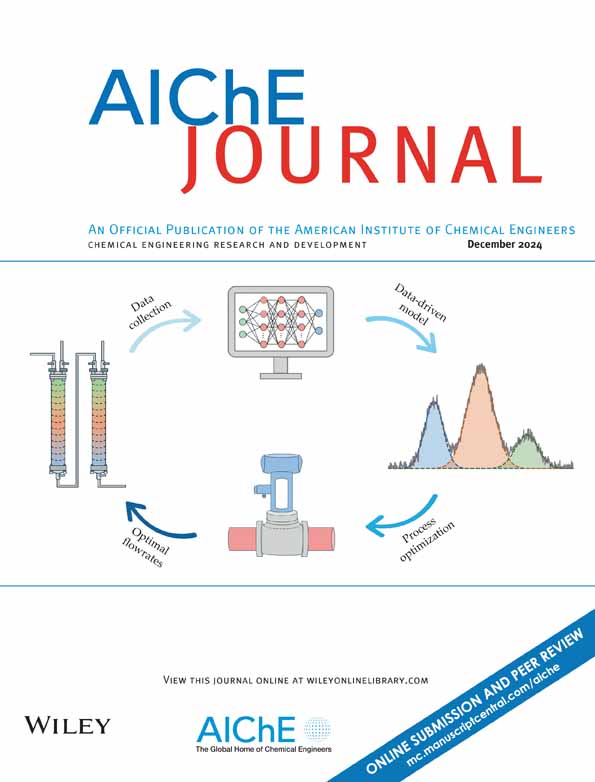从催化动力学的角度研究了聚离子液体中羟基对CO2与环氧化物环加成反应的作用
IF 3.5
3区 工程技术
Q2 ENGINEERING, CHEMICAL
引用次数: 0
摘要
二氧化碳与环氧化物的环加成反应可制得高价值的环状碳酸盐。本研究通过离子液体([HeVIM]Br或[BVIM]Br)、4-乙烯基苯酚和二乙烯基苯的共聚,制备了一系列羟基功能化咪唑基聚离子液体(pil)。研究了合成的聚吡咯作为环氧氯丙烷环加成CO2的催化剂,发现咪唑与羟基之间存在协同活化作用,聚吡咯具有较高的催化活性。优化后的PILs在1.0 MPa CO2和393 K条件下,2 h内的环碳酸盐收率为92.9%,在环境反应条件下(0.5 MPa CO2和303 K),环碳酸盐的生成速率为1.7 ~ 2.8 h−1。动力学实验和理论计算表明,氢键网络的存在降低了CO2环加成开环步骤的能垒,进一步促进了CO2在咪唑基上的转化。本文章由计算机程序翻译,如有差异,请以英文原文为准。
The role of hydroxyl groups in poly(ionic liquid)s on CO2 cycloaddition with epoxides in the view of catalytic kinetics
The cycloaddition of CO2 and epoxides can produce high-value cyclic carbonates. This study developed a series of hydroxyl functional imidazolium-based poly(ionic liquid)s (PILs) by copolymerization of ionic liquids ([HeVIM]Br or [BVIM]Br), 4-vinylphenol, and divinylbenzene. The as-synthesized PILs were investigated as catalysts for the cycloaddition of CO2 with epichlorohydrin, and higher catalytic activity was observed over PILs with the cooperative activation effect between imidazolium and hydroxyl groups. The optimized PILs could achieve a 92.9% yield of cyclic carbonate in 2 h at 1.0 MPa CO2 and 393 K, and a considerable cyclic carbonate formation rate of 1.7–2.8 h−1 at ambient reaction conditions (0.5 MPa CO2 and 303 K). Kinetic experiments and theoretical calculations indicate that the presence of a hydrogen bond network lowers the energy barrier of the ring-opening step in CO2 cycloaddition, further facilitating the CO2 conversion over imidazolium groups.
求助全文
通过发布文献求助,成功后即可免费获取论文全文。
去求助
来源期刊

AIChE Journal
工程技术-工程:化工
CiteScore
7.10
自引率
10.80%
发文量
411
审稿时长
3.6 months
期刊介绍:
The AIChE Journal is the premier research monthly in chemical engineering and related fields. This peer-reviewed and broad-based journal reports on the most important and latest technological advances in core areas of chemical engineering as well as in other relevant engineering disciplines. To keep abreast with the progressive outlook of the profession, the Journal has been expanding the scope of its editorial contents to include such fast developing areas as biotechnology, electrochemical engineering, and environmental engineering.
The AIChE Journal is indeed the global communications vehicle for the world-renowned researchers to exchange top-notch research findings with one another. Subscribing to the AIChE Journal is like having immediate access to nine topical journals in the field.
Articles are categorized according to the following topical areas:
Biomolecular Engineering, Bioengineering, Biochemicals, Biofuels, and Food
Inorganic Materials: Synthesis and Processing
Particle Technology and Fluidization
Process Systems Engineering
Reaction Engineering, Kinetics and Catalysis
Separations: Materials, Devices and Processes
Soft Materials: Synthesis, Processing and Products
Thermodynamics and Molecular-Scale Phenomena
Transport Phenomena and Fluid Mechanics.
 求助内容:
求助内容: 应助结果提醒方式:
应助结果提醒方式:


